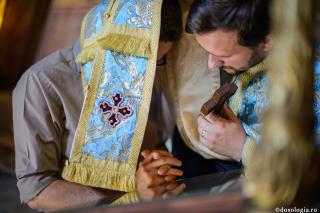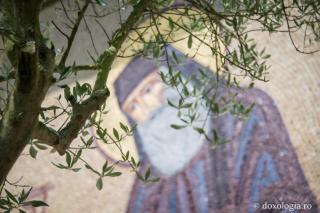"Greyhound" - a Movie We Were Expecting from Tom Hanks
The ship has always been a symbol of the Church on the turbulent sea of this post-Edenic life. It is being steered by Jesus Christ ("the Good Shepherd"). His apostles and their followers are called "fishers of men" (Matthew 4:19). The character Ernest Krause can easily be associated with one of the pastors of the Church, called to watch over the souls hunted by the relentless enemy of man - the devil.
He is considered the most famous actor of Eastern Orthodox faith in the world. While exceptionally diverse, his filmography did not include until now a movie imbued with a strong Christian message. Tom Hanks’s "Greyhound" has changed that. The film is a nice surprise coming from Apple, the producer of the film. In fact, "Greyhound" was released exclusively on Apple TV+ on July 10, 2020. It is an adaptation of the novel "The Good Shepherd" - quite a suggestive title, right? - published by one of the most prolific authors of stories of naval battles, the British writer CS Forester. The one who turned the book into a screenplay is none other than Tom Hanks, who has given himself thus the opportunity to artistically transpose his Christian belief.
I need to warn those who will read the article that I will reveal several details from the plot (thus I resort here to the so-called spoiler alert). On the outside, "Greyhound" is one of the many film productions about the involvement of the United States in World War II. In February 1942, a convoy of 37 ships crossed the North Atlantic Ocean carrying troops and supplies in support of the Allies. They were escorted by four warships led by Captain Ernest Krause - played by Tom Hanks - on his first mission. The film contains many Christian references from biblical quotations, to prayers said by Captain Krause. For example, when he throws into the sea the lifeless bodies of a few comrades, Tom Hanks makes Captain Ernest say the following: “Looking for the general Resurrection in their last day, and the life of the world to come, through our Lord Jesus Christ, at whose second coming in glorious majesty to judge the world, the sea shall give up her dead, and corruptible bodies of those who sleep in him, shall be changed and made like unto his glorious body according to the mighty working whereby he is able to subdue all things unto himself.” But, beyond the obvious or the clearly discernable Christian elements, we find a whole series of very well "camouflaged" Christian teachings and symbols.
Evelyn, the symbol of the Love we seek
The ship has always been a symbol of the Church on the turbulent sea of this post-Edenic life. It is being steered by Jesus Christ ("the Good Shepherd"). His apostles and their followers are called "fishers of men" (Matthew 4:19). The character Ernest Krause can easily be associated with one of the pastors of the Church, called to watch over the souls hunted by the relentless enemy of man - the devil. The ship that Ernest is in charge of is called the Greyhound (hence the title of the film). Yet under his command are also the other three: Harry, Dicky and Eagle. These four ships that accompany and guard the entire fleet (the "rational flock") send us thinking of the symbols of the four evangelists - for the demonic attacks and the temptations of the world can only be overcome by keeping the commandments of the Gospel. Dicky means "sickly" and can be associated with the man who appears in the iconography of Matthew’s Gospel (the one that talks about the human genealogy of the Lord). This "sick" humanity was assumed by the Savior in order to heal it. Harry points in English to the verb "to uncover" and can be associated with the calf that symbolizes Luke’s Gospel. It is the only Gospel that speaks of the "fattened calf" being slaughtered for us - the image of the Sacrifice of the Lord who "stripped" himself of his divinity (kenosis) and was crucified in the flesh on the Cross. The Eagle points most clearly to the eagle that symbolizes John’s Gospel (for the height of his theological ideas). The Greyhound can be associated with the lion painted by iconographers as a symbol of Mark’s Gospel (which speaks of "the voice of one crying in the wilderness").
During the battle, the Eagle ship is "lost", therefore only the other three reach their destination. It is a message for today's Christian, a message specific to an age in which it is extremely difficult to cultivate the contemplation instilled by the Gospel of John. Now is more the time for the action that pervades the other three synoptic Gospels, the one of Mark being the shortest of them. There is a certain pressure in this gospel, a desire to act. That is why the word "immediately" is used by Mark more than 40 times in just 16 chapters. Therefore, it is time to enter the struggle for salvation, one that must not be postponed for a single moment. "For the time is short" (1 Corinthians 7:29).
Before the actual action, Commander Ernest Krause meets with Evelyn, whom he would like to take with him in order to ask her to be his wife. Because they meet on Christmas Day, he offers her a symbolic gift with the inscription: "yesterday, today and forever". The text is inspired by the biblical Epistle to the Hebrews: "Jesus Christ is the same yesterday, today and forever " (Hebrews 13:8). This quote is also found at the beginning and end of the film on the mirror in his cockpit. Evelyn delicately refuses to accompany him: "The world has gone crazy. Let's wait until we can be together." Remaining true to his choice, Ernest tells her: “I will always be looking for you, Evie, no matter where I am (...). I will be hoping I’ll see you come around the corner." The fact that this meeting takes place on Christmas day reminds us of the Incarnation of the Lord. His coming to earth is the supreme gesture of love the Scripture speaks of: "We love God, because he first loved us" (1 John 4:19). Ernest represents the man eager to open up to this love, symbolized here by Evelyn. But, in order to acquire perfect love, one has to follow a path that is not at all easy, yet is simple at the same time.
Grace or "air cover"
The convoy of ships leaving the United States for Britain passes through three areas. On departure, it is supported by "air cover", but afterwards it is meant to cross, in the middle of the ocean, an area called the Black Pit for about 50 hours before receiving support again by means of military aircraft – this time, from the allies. These are also the three stages of the spiritual life that we find described in detail in the work of Archimandrite Zacharia Zacharou, "Remember Thy First Love". First, we have "cover from above" - we receive what is called the grace of "ill-deserved wealth" (see Luke 16:1-12). Then comes the generic period called the "grace of abandonment," when we go through temptations that are useful for our salvation. In the end, we come to enjoy the protective grace again, a grace that "is no longer taken from us."
Even in the most difficult period, when our subjective perception can make us believe that God has left us, in fact grace continues to (co)operate. Suggestive is the sequence in the film in which, in the middle of a very hard battle, the camera rises to the clouds, revealing a beautiful aurora borealis. Just as the particles of the solar wind enter Earth's magnetic field and create this phenomenon that can be noticed by our eyes, so the spiritual man can "perceive" the presence of divine grace even in the most terrible moments (see the lives of the holy martyrs). Between the first moment of air coverage and the next, the convoy of ships travels a 50-hour route. It is a number with deep Christian meanings. The number 50 can be broken down into seven times seven (49), to which is added another day. Seven is the number of days of creation, and the day that is added is the Day of Pentecost, the Eighth (the day of the Resurrection and the "Unending Kingdom").
Captain Ernest Krause (Tom Hanks) is a true shepherd, a fact accentuated symbolically by the fact that, when the fights begin, he asks for "the sheepskin coat" and "the fur gloves, not the knitted ones". In the film there is also a moment when he leaves the 99 sheep to look for the lost one (cf. Matthew 18:12): he stops to save 28 people from a ship sunk by the enemy, instead of going immediately to the whole convoy. Throughout the fights, even in moments of calm - that is, about 48 hours -, he does not eat anything that the cook keeps bringing him and is always standing. It is an illustration of the exhortation: "Watch ye and pray, lest ye enter into temptation" (Mark 14:38). When his legs bleed, he puts on a pair of slippers received as a gift from his girlfriend, Evie. In the spiritual life too, in the moments close to despair, one can appeal to the “comfort” of that tea recommended by Saint Sophrony Sakharov to a stunned monk who has reached the limit of his spiritual powers. The end will find him with discreet tears in his eyes, yet impassive to the ovations of those expressing their gratitude. It is the attitude of a man who knows that he owes everything to God, especially victory in battle.
Spiritual struggles on the sea of life
The naval battle fought by Greyhound shows us how important it is to involve everyone and carry out exactly the orders received from Commander Krause. It is also essential in the Church to respect the hierarchy and to follow the spiritual leaders. Repelling the attack of the first submarine is "a success for everyone". This does not mean that "spiritual flock" cannot come up with very useful suggestions - when they, for example, draw the captain's attention to the fact that resources are being wasted out of the desire to strike the enemy. As in any community, there are moments of internal tension. The two American soldiers who fight each other regret their deed in front of Captain Krause, neither of them seeks to justify themselves (they are, thus, the image of repentance). Therefore, the Captain no longer punishes them, but only asks them to "restore the relationships" and " fill me with peace."
The Greyhound ship has a surface radar, but also a sonar - the spiritual battles take place in visible areas, but also in the still unexplored depths of the heart. The danger that comes from Nazi submarines is most often difficult to perceive. The work of the devil is not usually visible to us either. But there are also times when the submarines rise to the surface - that is, sometimes the work of the enemy reveals itself clearly, the fight is in the open.
Beyond the actual fight, the one carried out with weapons (temptations through which we are attacked to arouse passions), there is also a real psychological war waged by the Nazis. They go on the radio several times and tell the Americans that they cannot escape and that their loved ones will suffer for their deaths. These messages are transmitted from a submarine called the Gray Wolf. At the end of one of these threats, the enemy voice says, "The Gray Wolf is so very hungry!" and ends with a scream. This is an opportunity to remind us of this warning: “Remain sober and alert, for your enemy the devil is on the prowl like a roaring lion, looking for someone to devour.” (1 Peter 5:8). Captain Krause asks for a change in the frequency following the first radio interferences by the enemy, but he does not react to the last one. The man hardened in spiritual struggles can hear the voice of the enemy without being disturbed.
These submarines, a real "pack of wolves", are "waiting for nightfall": "The night cometh when no man can work, Ernie” - says Charlie, the second in command. A line inspired by: "I must do, until daybreak, the works of the One who sent Me; for the night cometh, when no man can work” (John 9:4). In temptation, the devil deceives us a lot and always tries to distract us. This is what happens in the movie, when an enemy submarine uses a bait so that the Americans would waste their ammunition by hitting empty.
After the first submarine sank, a crew member enthusiastically tells Commander Krause, "Fifty less Krauts!" As a Christian, the captain gives him a reply meant to make him think: "Fifty souls...". The devil also attacks us through people, but they are not our real enemies. Our hearts must weep for any soul lost through the work of Satan.
Increasing the intensity of the spiritual struggle also means reaching moments when the spiritual man seems to break all rules and patterns, as we see happening with the Desert Fathers of the Apothegmata Patrum. Commander Krause declares, towards the end of crossing that Black Pit, that "We need to break the protocol (...), No more zigzags, no evasive maneuvers," in order to reach "as soon as possible the air cover". The message of help sent to the Admiralty ends up being condensed into a single word: Help!, so as not to be intercepted by enemies. Likewise in the spiritual life we communicate succinctly, so as not to give the enemy a chance to attack us – by learning our thoughts.
After reading some reviews of the film written in the USA, I noticed that some are bothered by the phenomenon of repetition: about half of the total dialogues consist of repeated military commands or reports. This is a stylistic process often used in the Holy Scriptures, especially in the Old Testament, appreciated even by someone such as Emil Cioran who says, in one of his texts, that only by going through them patiently can you “understand how beautiful it is”. Of course, we have in mind here a kind of Dostoevskyan beauty, i.e., of the sort that will save the world. This type of beauty informs "Greyhound" - an amazing film, given the current era of cinema and the sort of values Hollywood usually promotes nowadays. This film is equivalent to an icon of the spiritual struggle, in which the constant call for God's help and the assurance that He is the One who "will with the temptation also make a way to escape" (I Corinthians 10:13) are essential.






